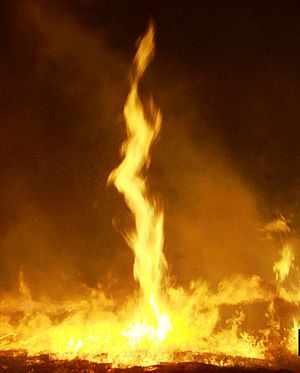Fire whirl facts for kids
Quick facts for kids Fire whirl |
|
|---|---|

A fire whirl with flames in the vortex
|
|
| Area of occurrence | Worldwide (most frequent in areas subject to wildfires) |
| Season | All year (most frequent in dry season) |
| Effect | Wind damage, burning, propagation/intensification of fires |
A fire whirl or fire devil (sometimes referred to as a fire tornado), is a whirlwind induced by a fire and often (at least partially) composed of flame or ash. These start with a whirl of wind, often made visible by smoke, and may occur when intense rising heat and turbulent wind conditions combine to form whirling eddies of air. These eddies can contract a tornado-like vortex that sucks in debris and combustible gases.
The phenomenon is sometimes labeled a fire tornado, firenado, fire swirl, or fire twister, but these terms usually refer to a separate phenomenon where a fire has such intensity that it generates an actual tornado. Fire whirls are not usually classifiable as tornadoes as the vortex in most cases does not extend from the surface to cloud base. Also, even in such cases, those fire whirls very rarely are classic tornadoes, as their vorticity derives from surface winds and heat-induced lifting, rather than from a tornadic mesocyclone aloft.
The phenomenon was first verified in the 2003 Canberra bushfires and has since been verified in the 2018 Carr Fire in California and 2020 Loyalton Fire in California and Nevada.
Contents
Formation
A fire whirl consists of a burning core and a rotating pocket of air. A fire whirl can reach up to 2,000 °F (1,090 °C). Fire whirls become frequent when a wildfire, or especially firestorm, creates its own wind, which can spawn large vortices. Even bonfires often have whirls on a smaller scale and tiny fire whirls have been generated by very small fires in laboratories.
Most of the largest fire whirls are spawned from wildfires. They form when a warm updraft and convergence from the wildfire are present. They are usually 10–50 m (33–164 ft) tall, a few meters (several feet) wide, and last only a few minutes. Some, however, can be more than 1 km (0.6 mi) tall, contain wind speeds over 200 km/h (120 mph), and persist for more than 20 minutes.
Fire whirls can uproot trees that are 15 m (49 ft) tall or more. These can also aid the 'spotting' ability of wildfires to propagate and start new fires as they lift burning materials such as tree bark. These burning embers can be blown away from the fire-ground by the stronger winds aloft.
Fire whirls can be common within the vicinity of a plume during a volcanic eruption. These range from small to large and form from a variety of mechanisms, including those akin to typical fire whirl processes, but can result in Cumulonimbus flammagenitus (cloud) spawning landspouts and waterspouts or even to develop mesocyclone-like updraft rotation of the plume itself and/or of the cumulonimbi, which can spawn tornadoes similar to those in supercells. Pyrocumulonimbi generated by large fires on rare occasion also develops in a similar way.
Classification
There are currently three widely recognized types of fire whirls:
- Type 1: Stable and centered over burning area.
- Type 2: Stable or transient, downwind of burning area.
- Type 3: Steady or transient, centered over an open area adjacent to an asymmetric burning area with wind.
There is evidence suggesting that the fire whirl in the Hifukusho-ato area, during the 1923 Great Kantō earthquake, was of type 3. Other mechanism and fire whirl dynamics may exist. A broader classification of fire whirls suggested by Forman A. Williams includes five different categories:
- Whirls generated by fuel distribution in wind
- Whirls above fuels in pools or on water
- Tilted fire whirls
- Moving fire whirls
- Whirls modified by vortex breakdown
The meteorological community views some fire-induced phenomena as atmospheric phenomena. Using the pyro- prefix, fire-induced clouds are called pyrocumulus and pyrocumulonimbus. Larger fire vortices are similarly being viewed. Based on vortex scale, the classification terms of pyronado, "pyrotornado", and "pyromesocyclone" have been proposed.
Blue whirl
In controlled small-scale experiments, fire whirls are found to transition to a mode of combustion called blue whirls. The name blue whirl was coined because the soot production is negligible, leading to the disappearance of the yellow color typical of a fire whirl. Blue whirls are partially premixed flames that reside elevated in the recirculation region of the vortex-breakdown bubble. The flame length and burning rate of a blue whirl are smaller than those of a fire whirl.
See also
 In Spanish: Remolino de fuego para niños
In Spanish: Remolino de fuego para niños

